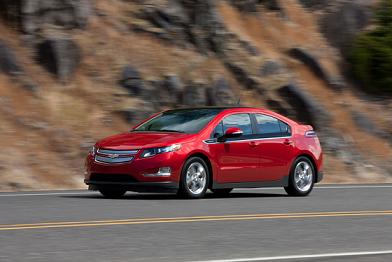
| Monday, October 03, 2011 | Archives | Advertise | Online Buyer's Guide | FLEETSolutions |
Chevy To Build The Volt In China
 General Motors Co. agreed on September 20 to deepen cooperation with its flagship Chinese partner on development of electric vehicle know-how amid pressure from Beijing to hand over proprietary technology. General Motors Co. agreed on September 20 to deepen cooperation with its flagship Chinese partner on development of electric vehicle know-how amid pressure from Beijing to hand over proprietary technology.Investments and other details of the plan were not provided, and it was unclear if the agreement was the result of a renewed push by China to acquire advanced technology its own automakers still lack. GM plans to start selling the Volt in China by the end of the year, but its prospects are iffy because it doesn't qualify for a Chinese government subsidy that amounts to $19,000 per car. The government offers the subsidy only to electric cars made in China. GM spokesman Jay Cooney in Detroit said the company has not been pressured by the Chinese government to share the Volt technology and has no plans to share it. He said GM is working with the Chinese government in an effort to get the subsidy for the Volt because it helps reach a government goal of getting more electric vehicles on the road. The cooperation agreement was signed during a meeting of the U.S. automaker's board in Shanghai — a visit underscoring China's importance to the company's future. It was the GM board's first meeting outside of the U.S. Cooney said the companies will work together to develop a new fully electric car. The Volt can travel about thirty-five miles on battery power, and a gas-powered generator kicks in to run the car when the batteries are depleted. The generator technology eliminates anxiety over whether a driver will run out of electricity. Tuesday's agreement follows an earlier memorandum of understanding on GM-SAIC cooperation signed in November. The choice of China for the board meeting reflects the country's crucial status as the world's biggest market for sales of new vehicles, despite a recent decline from double-digit growth. GM's Chairman Dan Akerson met Monday with more than 700 employees at GM's campus in Shanghai's eastern suburbs. Shanghai is the site of GM's international headquarters and its highly successful venture with state-owned SAIC, which on Monday rolled out the five millionth vehicle since production began in late 1998. The push for more advanced technology reflects China's frustrations with its continued weakness in automotive technology, analysts say. After twenty-five years of auto joint ventures that require local partners to hold at least a fifty percent stake, domestic automakers still lag behind their global rivals as they struggle to master the complexities of 21st century automotive engineering. An explosion in Chinese demand and sluggish sales in the recession-stricken West helped China overtake the U.S. as the largest car market in 2009. Last year, sales of passenger vehicles, excluding large buses, jumped by a third to 13.7 million vehicles. Although growth in the overall market has slowed in recent months, GM's sales in China still jumped 13.4 percent in August from a year earlier to a record 205,885 vehicles for the month. A large share of the company's growth has come from sales of its mini vehicles in another venture, SAIC-GM-Wuling, but strong demand for foreign-brand sedans and sport-utility vehicles has also helped. |
 |
NAFA Fleet Management Association 125 Village Blvd., Suite 200 Princeton, NJ 08540 Telephone: 609.720.0882 Fax: 609.452.8004 |








